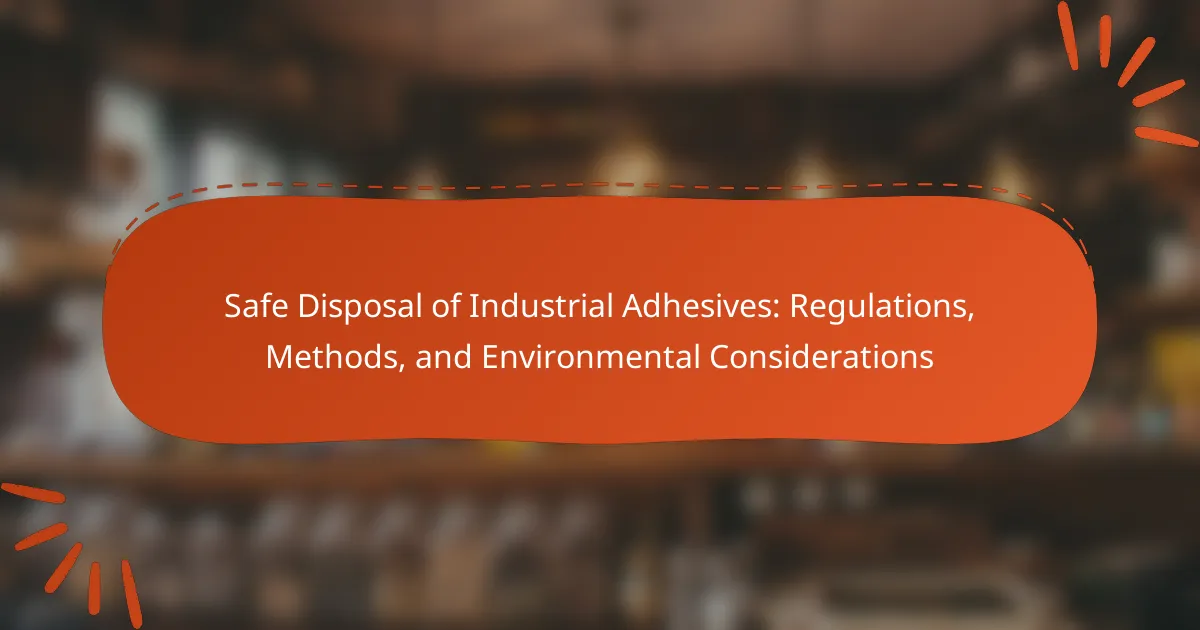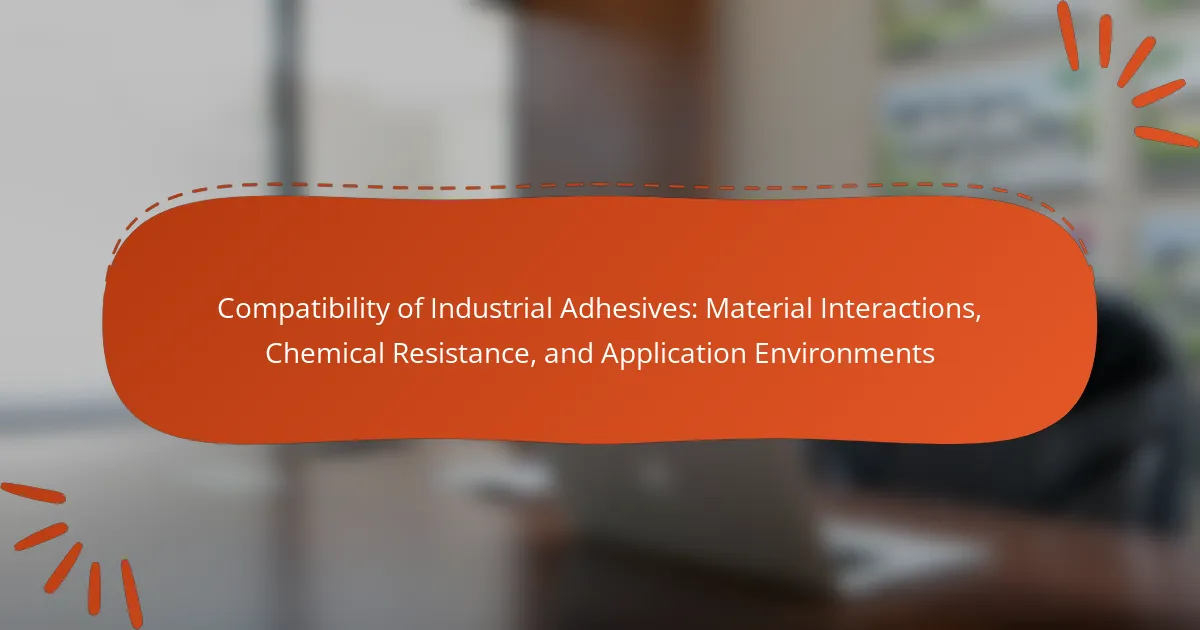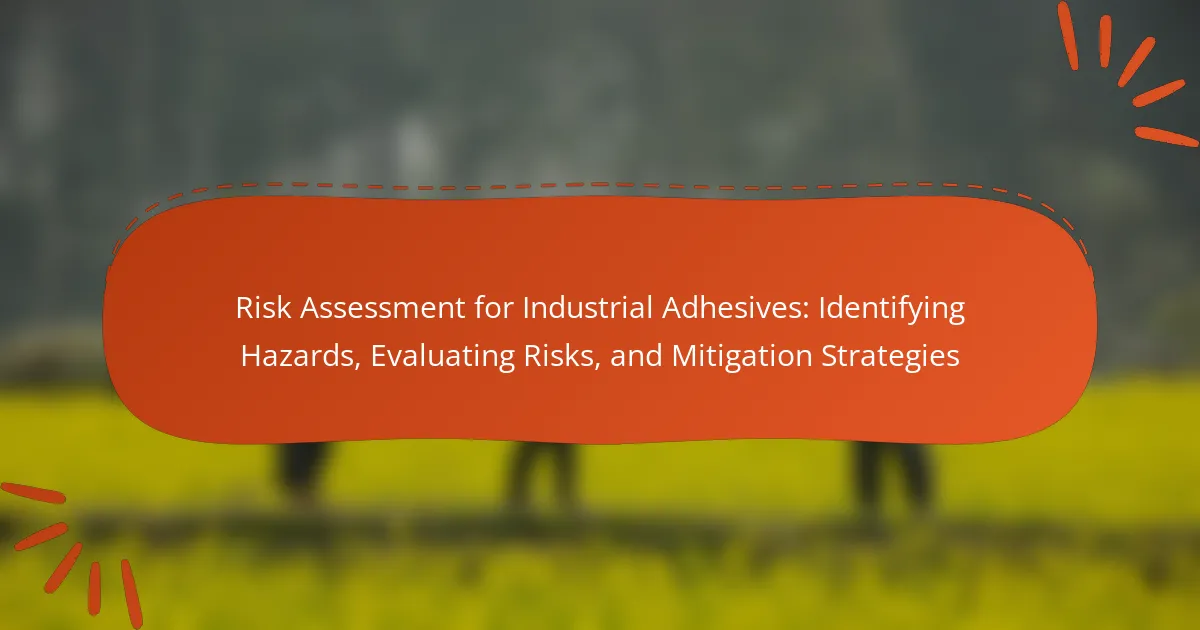The safe disposal of industrial adhesives is governed by key regulations such as the Resource Conservation and Recovery Act (RCRA) and the Clean Water Act (CWA). The RCRA outlines guidelines for hazardous waste management, categorizing adhesives based on their chemical properties and environmental impact, while the CWA regulates pollutant discharges into U.S. waters. Several disposal methods, including recycling, incineration, and disposal at hazardous waste facilities, are essential for compliance with these regulations and for protecting public health. Additionally, understanding local regulations and proper identification of adhesive types is crucial to minimize environmental contamination and ensure safe disposal practices.
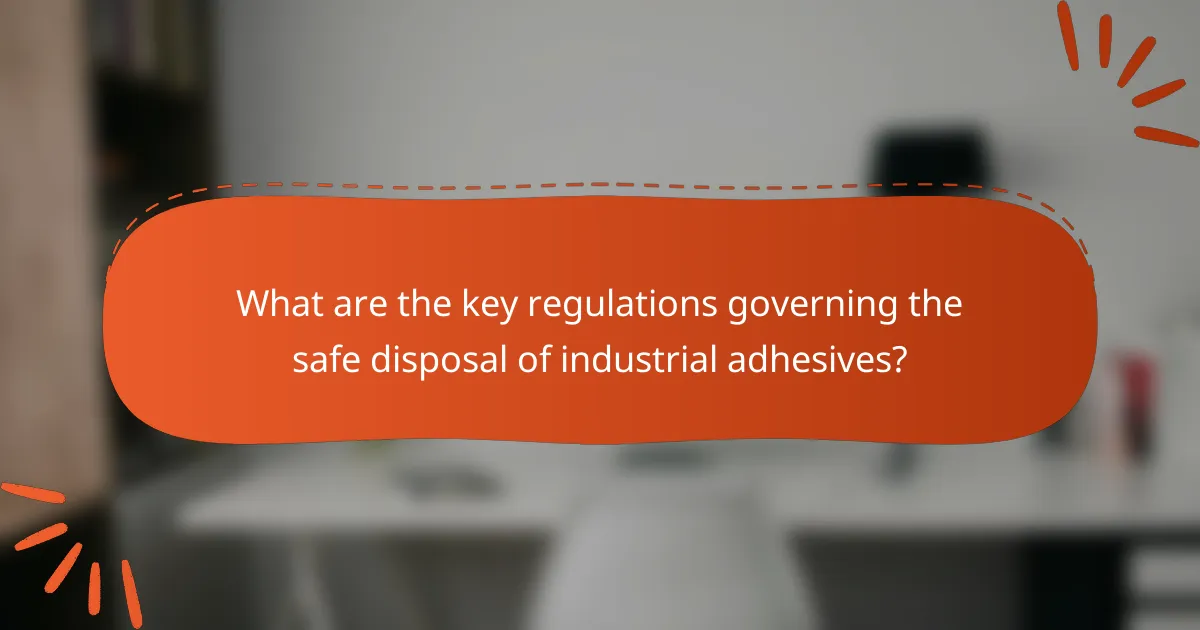
What are the key regulations governing the safe disposal of industrial adhesives?
The key regulations governing the safe disposal of industrial adhesives include the Resource Conservation and Recovery Act (RCRA) and the Clean Water Act (CWA). The RCRA establishes guidelines for hazardous waste management, including adhesives that contain toxic substances. Under the RCRA, industrial adhesives are categorized based on their chemical properties and potential environmental impact. The CWA regulates discharges of pollutants into U.S. waters, affecting how adhesives are disposed of to prevent water contamination. Additionally, local and state regulations may impose stricter requirements for disposal methods. Compliance with the Occupational Safety and Health Administration (OSHA) standards is also essential for worker safety during disposal processes.
How do federal and state regulations differ regarding industrial adhesive disposal?
Federal regulations for industrial adhesive disposal are primarily governed by the Resource Conservation and Recovery Act (RCRA). This act categorizes hazardous waste and outlines specific disposal methods. State regulations can vary significantly, as states have the authority to implement more stringent measures than federal standards. Some states may require additional permits or specific disposal facilities for industrial adhesives. For instance, California’s hazardous waste regulations often exceed federal requirements. Compliance with both federal and state regulations is essential for proper disposal. Failure to adhere to these regulations can result in fines and legal repercussions.
What specific guidelines must industries follow to comply with these regulations?
Industries must follow specific guidelines for the safe disposal of industrial adhesives. These guidelines include adhering to local, state, and federal regulations regarding hazardous waste management. Industries must classify adhesives as hazardous or non-hazardous based on their chemical composition. Proper labeling of adhesive containers is essential to ensure safe handling. Additionally, industries must conduct regular training for employees on safe disposal practices. They should also maintain accurate records of adhesive use and disposal methods. Compliance with the Resource Conservation and Recovery Act (RCRA) is mandatory for hazardous waste. Regular audits and inspections can help ensure adherence to these guidelines.
What penalties exist for non-compliance with adhesive disposal regulations?
Penalties for non-compliance with adhesive disposal regulations can include fines, legal action, and remediation costs. Fines can range from hundreds to thousands of dollars per violation. Legal action may involve criminal charges for severe breaches of regulations. Companies may also face mandatory cleanup and disposal costs for improperly managed adhesives. Regulatory agencies enforce these penalties to ensure compliance and protect the environment. Non-compliance can lead to reputational damage and loss of business licenses. Specific penalties vary by jurisdiction and the extent of the violation.
What role do safety data sheets (SDS) play in adhesive disposal?
Safety data sheets (SDS) provide critical information for the safe disposal of adhesives. They outline the hazards associated with the chemical components of adhesives. SDS include guidelines on proper handling, storage, and disposal methods. They also specify any regulatory requirements for disposal. Understanding this information helps ensure compliance with environmental regulations. Additionally, SDS offer emergency contact information and first-aid measures in case of exposure. Ensuring proper disposal minimizes environmental impact and health risks. Thus, SDS are essential for safe adhesive disposal practices.
How can SDS help in identifying hazardous properties of adhesives?
SDS, or Safety Data Sheets, help identify hazardous properties of adhesives by providing detailed information about their chemical composition and potential risks. Each SDS contains sections on hazards, handling, and emergency measures. This information allows users to understand toxicity, flammability, and reactivity of adhesives. For example, Section 2 of an SDS outlines hazard identification, including health effects and environmental impacts. Additionally, Section 3 lists ingredients and their concentrations. This enables users to assess safety measures needed during use and disposal. Thus, SDS are essential for ensuring safe handling and compliance with regulations related to hazardous materials.
What information should be included in an SDS for industrial adhesives?
An SDS for industrial adhesives should include identification, hazard identification, composition, first-aid measures, firefighting measures, accidental release measures, handling and storage, exposure controls, and physical and chemical properties. Identification provides the product name and manufacturer details. Hazard identification outlines potential risks associated with the adhesive. Composition lists chemical ingredients and their concentrations. First-aid measures detail steps for treating exposure. Firefighting measures recommend suitable extinguishing methods. Accidental release measures guide cleanup procedures. Handling and storage specify safe practices. Exposure controls recommend personal protective equipment. Physical and chemical properties describe characteristics like appearance and boiling point. These sections ensure safe use and compliance with regulations.
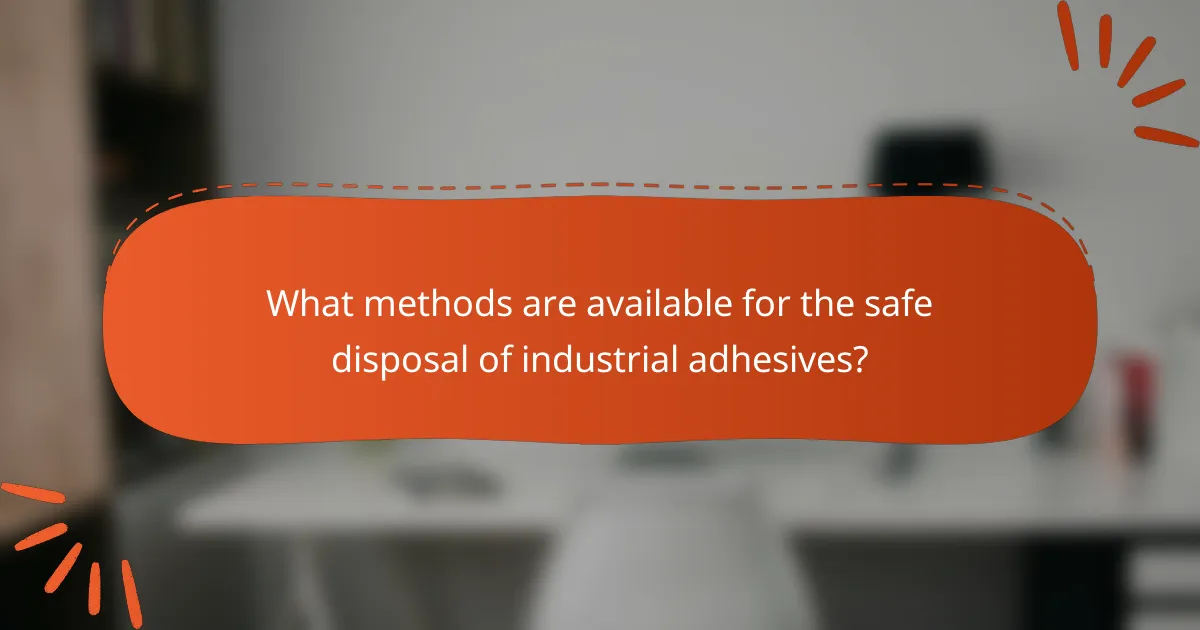
What methods are available for the safe disposal of industrial adhesives?
The safe disposal of industrial adhesives can be achieved through several methods. These include recycling, incineration, and disposal at hazardous waste facilities. Recycling involves processing adhesives to recover materials for reuse. Incineration safely burns adhesives at high temperatures, reducing them to ash and gases. Disposal at hazardous waste facilities ensures that adhesives are handled according to environmental regulations. These methods comply with regulations set by environmental agencies. Proper disposal prevents environmental contamination and protects public health.
What are the most common disposal methods for industrial adhesives?
The most common disposal methods for industrial adhesives include incineration, recycling, and landfill disposal. Incineration involves burning adhesives at high temperatures, effectively reducing their volume and potential environmental impact. Recycling is an emerging method where adhesives are processed for reuse, minimizing waste. Landfill disposal is often used but is less environmentally friendly due to the potential for leachate contamination. Regulatory guidelines often dictate specific disposal methods based on the adhesive’s chemical composition. For example, hazardous adhesives may require specialized disposal to prevent environmental harm. Proper disposal methods are essential to comply with environmental regulations and ensure safety.
How does incineration work as a disposal method for adhesives?
Incineration works as a disposal method for adhesives by combusting them at high temperatures. This process reduces adhesives to their basic chemical components. The incineration of adhesives generates heat, which can be harnessed for energy. It also minimizes the volume of waste significantly. The high temperature ensures the breakdown of harmful substances. Emissions from incineration are controlled to minimize environmental impact. Advanced incineration facilities use scrubbers to filter pollutants. This method complies with regulations for hazardous waste disposal.
What are the benefits and drawbacks of landfill disposal for adhesives?
Landfill disposal for adhesives has both benefits and drawbacks. One benefit is that it provides a straightforward method for disposing of large quantities of waste. Landfills can accommodate various types of adhesives, including those that are not easily recyclable. This method can also reduce immediate environmental hazards by containing waste in a designated area.
However, drawbacks include potential environmental contamination. Adhesives may leach harmful chemicals into the soil and groundwater over time. Additionally, landfill space is finite, leading to increased pressure on waste management systems. The breakdown of adhesives in landfills can produce methane, a potent greenhouse gas. Therefore, while landfill disposal is convenient, it poses significant environmental risks.
What innovative disposal technologies are being developed for adhesives?
Innovative disposal technologies for adhesives include enzymatic degradation, thermal depolymerization, and solvent extraction methods. Enzymatic degradation utilizes specific enzymes to break down adhesive polymers into non-toxic byproducts. This method is effective for water-based adhesives and reduces environmental impact. Thermal depolymerization involves heating adhesives to break them down into simpler compounds, which can then be repurposed. Solvent extraction techniques use solvents to dissolve adhesives, allowing for easier separation and recovery of base materials. These technologies aim to minimize landfill waste and promote recycling in the adhesive industry.
How do chemical recycling processes work for adhesive materials?
Chemical recycling processes for adhesive materials involve breaking down polymers into their chemical building blocks. This is achieved through methods such as depolymerization or solvolysis. In depolymerization, heat and catalysts are used to reverse the polymerization process. Solvolysis involves using solvents to dissolve adhesives and separate components.
These processes allow for the recovery of valuable monomers. The recovered monomers can be repurposed to create new adhesive materials. According to a study by the European Commission, chemical recycling can significantly reduce waste and environmental impact. This method also minimizes the need for virgin raw materials.
By recycling adhesive materials chemically, industries can enhance sustainability. This aligns with regulations aimed at reducing hazardous waste. Thus, chemical recycling processes contribute to safer disposal and environmental conservation.
What role does bioremediation play in adhesive disposal?
Bioremediation plays a crucial role in adhesive disposal by utilizing microorganisms to degrade hazardous components. This process effectively reduces the environmental impact of adhesives. Microbial strains can break down complex organic compounds found in adhesives. Studies show that certain bacteria can metabolize these compounds, transforming them into less harmful substances. For instance, research indicates that specific fungi can degrade polyvinyl acetate, a common adhesive component. This method not only minimizes waste but also promotes environmental sustainability. Bioremediation offers a viable alternative to traditional disposal methods, such as incineration or landfilling.
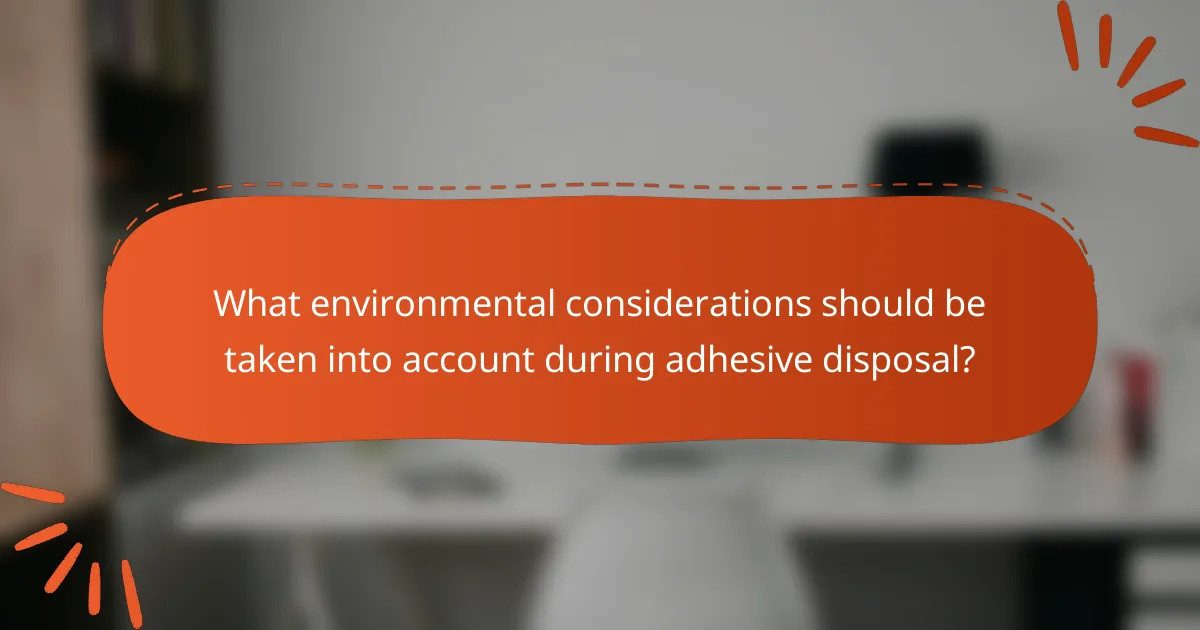
What environmental considerations should be taken into account during adhesive disposal?
Environmental considerations during adhesive disposal include proper identification of adhesive types. Different adhesives contain varying chemicals that may be hazardous. Understanding local regulations for hazardous waste is essential. Many adhesives require specific disposal methods to prevent environmental contamination. Recycling options should be explored where applicable. Safe storage before disposal is necessary to avoid leaks. Community guidelines on disposal can also provide valuable information. These measures help minimize environmental impact and ensure compliance with legal standards.
How does improper disposal of adhesives impact the environment?
Improper disposal of adhesives negatively impacts the environment by contaminating soil and water sources. Many adhesives contain harmful chemicals that can leach into the ground. This contamination can affect plant growth and harm wildlife. Additionally, when adhesives are improperly incinerated, they can release toxic fumes into the air. These emissions contribute to air pollution and can pose health risks to humans and animals. Studies have shown that hazardous waste from adhesives can persist in the environment for years. Proper disposal methods are essential to mitigate these risks and protect ecosystems.
What are the potential risks to soil and water quality?
Industrial adhesives pose several potential risks to soil and water quality. These adhesives often contain harmful chemicals that can leach into the soil. Contaminated soil can lead to reduced fertility and harm plant growth. When rainwater or runoff occurs, these chemicals can also enter water bodies. This contamination can affect aquatic life and disrupt ecosystems. Studies indicate that certain adhesive components are toxic to fish and other organisms. Additionally, improper disposal methods can exacerbate these risks. Regulations exist to mitigate these dangers, but enforcement varies. Overall, the risks to soil and water quality from industrial adhesives are significant and require careful management.
How can air quality be affected by adhesive disposal practices?
Adhesive disposal practices can significantly affect air quality. Improper disposal methods release volatile organic compounds (VOCs) into the atmosphere. VOCs contribute to air pollution and can lead to respiratory issues. Burning adhesives without appropriate controls emits harmful particulates and gases. These emissions can degrade local air quality and pose health risks. According to the Environmental Protection Agency (EPA), VOCs are a major concern in urban areas. They can react with sunlight to form ground-level ozone, a key component of smog. Effective disposal practices can mitigate these impacts and protect air quality.
What best practices should industries adopt for environmentally friendly adhesive disposal?
Industries should adopt several best practices for environmentally friendly adhesive disposal. First, they should implement recycling programs for adhesive containers. This reduces waste and encourages material reuse. Second, industries must train employees on proper disposal methods. Educated staff can minimize environmental impact. Third, using biodegradable adhesives can significantly reduce harmful waste. Research shows that biodegradable options break down more easily in landfills. Fourth, industries should collaborate with hazardous waste disposal companies. These firms specialize in safe disposal practices. Finally, regular audits of disposal practices can identify areas for improvement. Continuous assessment ensures compliance with environmental regulations.
How can companies develop a waste management plan for adhesives?
Companies can develop a waste management plan for adhesives by following a systematic approach. First, they should conduct a waste assessment to identify adhesive types and quantities used. Next, they must comply with local regulations regarding hazardous waste disposal. This includes understanding the classification of adhesives as hazardous or non-hazardous.
Then, companies should implement waste minimization strategies. These can include optimizing adhesive application processes to reduce excess waste. Training employees on proper adhesive handling and disposal is also essential.
Finally, companies should establish partnerships with certified waste disposal vendors. This ensures that adhesives are disposed of in an environmentally responsible manner. Regularly reviewing and updating the waste management plan is crucial to adapt to changes in regulations or adhesive formulations.
What steps can be taken to minimize adhesive waste generation?
Implementing efficient adhesive application techniques minimizes adhesive waste generation. Utilizing precise dispensing systems ensures accurate application, reducing excess use. Training employees on proper adhesive use enhances their skills and awareness. Regular maintenance of equipment prevents leaks and malfunctions, which contribute to waste. Selecting adhesives with longer open times allows for better adjustments and minimizes excess. Recycling unused adhesive materials when possible further reduces waste. Conducting regular audits of adhesive usage identifies areas for improvement and waste reduction. These steps collectively lead to a significant decrease in adhesive waste in industrial settings.
What resources are available for industries looking to improve adhesive disposal practices?
Industries can access several resources to improve adhesive disposal practices. The Environmental Protection Agency (EPA) provides guidelines on hazardous waste management. The American National Standards Institute (ANSI) offers standards for waste disposal processes. Industry associations, such as the Adhesive and Sealant Council (ASC), publish best practices and technical papers. Local waste management authorities often have specific regulations and resources. Online training programs are available to educate employees on safe disposal methods. Additionally, consulting firms specialize in waste management solutions tailored for specific industries. These resources are essential for compliance and environmental sustainability.
The main entity of this article is the safe disposal of industrial adhesives. Key regulations, including the Resource Conservation and Recovery Act (RCRA) and the Clean Water Act (CWA), establish guidelines for hazardous waste management and pollutant discharge. The article outlines the differences between federal and state regulations, specific compliance guidelines for industries, and the penalties for non-compliance. It discusses various disposal methods, including recycling and incineration, as well as innovative technologies like enzymatic degradation and bioremediation. Environmental considerations, risks to soil and water quality, and best practices for waste management are also examined to ensure sustainable adhesive disposal.
